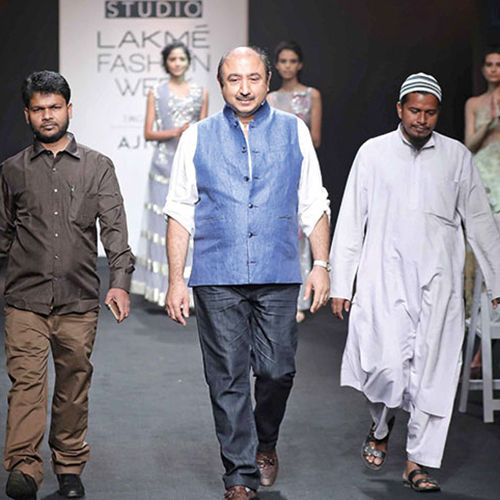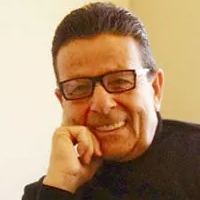
Jay Ramrakhiani
Designer
Occasions Elegance Wear
Varanasi Weavers need guidance, Not charity
It is believed that by early 19th century, Varanasi weavers had moved away from weaving cotton and started working on fine organza silk. History has it that the fame of Banarasi sarees had long peaked during the Mughal era in the 1600s. Traditional motifs were then combined with Persian designs.
Fibre2Fashion: Tell us something about your fashion background.
Jay Ramrakhiani:
My passion for fashion spans over three decades, which began with my being an intern in the Far East and continued when I was an apprentice in the West with Stellar Fashion Maisons. My presence was felt at the Katy Ford supermodel pageant in 1996 when Bipasha Basu was bestowed with the Super Model status in Miami, and my reputation was further enhanced by my contribution at the prestigious Miss India contests - specially the cocktail/eveningwear gowns and formal ensembles for the crown winners. A step ahead saw me featured in the BBC's Style segment several times and on Zee Canada slots for my contribution to the fashion industry, being called the 'Armani of India' by Debonair in 2002, and also being described as 'Banarasi Babu' by Verve in 2013. Corporate, fusion, Indian and western wear are my forté, and I was the first to work on prét lines of separates, using jute fabrics and linen for comfortable formal and informal wear, which was a revolutionary idea and won me many accolades across the globe.
F2F: For how long were you the design head for the Taj Group of hotels?
JR:
I have been associated with the Indian Hotels Company (IHCL), which is the Taj Group of Hotels, for the last 20-odd years and have been instrumental in branding the luxury group via my identity apparels and the Banaras weaves for the front line, housekeeping staff and personnel at their fine dining restaurants including the famous Japanese restaurant Wasabi.
F2F: When did you get involved with Varanasi weavers?
JR:
The Varanasi weavers project began in 2007 when Ratna Krishnakumar, wife of then (IHCL) vice chairman RK Krishnakumar, saw a documentary on television about the plight of the weavers and decided to help them.
F2F: The Taj Group had adopted clusters or villages of weavers. How successful was the idea and what part did you play in it?
JR:
The Taj Group adopted a village called Sarai Mohanna. It was one of the prime weaving villages of its time, which has since been revived, and is now successfully running to full capacity by weaving uniform sarees, blouses and winter jackets. I was roped in to help design and mentor the weavers towards the vision that had been envisaged (by Taj). Besides these, medical and eye camps, hygiene issue, water pumps, education, and accountability were also monitored by me. In short, I was responsible for sustaining the village and its inhabitants.
F2F: Could you outline some of the details?
JR:
I was commissioned to design and work closely with the weavers in the village, and help sustain the legacy by way of weaving uniform sarees, blouses, winter jackets and fabrics for the front and housekeeping staff across all luxury hotels and palaces of the Taj Group.
F2F: How many sarees and textiles were you able to create in a year?
JR:
Nearly 300-350 uniform sarees were woven in a year. Another 35-50 revival sarees were woven by master weavers and a further 8-10 different textured weaves were created as textiles for made-ups.
F2F: Have you adopted any cluster personally?
JR:
I'm mentoring a village called Milkipur on the outskirts of Ramnagar.
F2F: How have you contributed to the lives of the weavers in Varanasi?
JR:
I would say that my contribution is all the above, and a commitment to keep the looms active and making a pledge for sustaining the legacy of the artisans.
F2F: How easy or difficult was it to coordinate and connect with the weavers?
JR:
The plight of the weavers and their families was in a sad state when we first met them, and it took us a while to win their trust. We had to hand-hold them initially by giving food to eat and yarn to start weaving, and slowly take it forward by organising medical and hygiene camps, install water pumps and solar lights, facilitate schooling for the children, build bathrooms, open bank accounts... you name it and it was done.
F2F: What were your innovations in the designs of textiles from Varanasi?
JR:
Traditional weaving of a saree consists of body, pallav and border with butties spread across in one or two colours. But my designs consist of the modern merging with traditional weaves for the young and youthful staff with more than three colours and a different design for the body, pallav, border and blouse. The weavers took some time to adapt to newer designs compared to what they were weaving, and have since churned out 100-125 designs so far, which includes those from my master weavers too.
F2F: How many weavers are working for you now?
JR:
Today, I can boast and am proud of keeping the handloom heritage alive as I have adopted a village besides managing one for the Taj Group and have around 150 weavers across Varanasi working on different designs and weaves at any given time.
F2F: What are the weaves and patterns that you are working on right now?
JR:
For the last three years, my efforts have been focused on creating a fusion of weaves like the Mughal Kinkhab, Kashmiri jamavaar blended with tanchois woven in a light weave.
F2F: How many designs did you create for the Taj Group?
JR:
I revived 50-odd designs and have also managed to merge old techniques with modern aesthetics with success, but the truth is... this is still not enough to keep the weavers afloat. If drastic steps are not taken, then this beautiful craft will be lost forever. The designers can form a guild and appoint me or someone with a good background of design and weaves to create patterns required by them. But this has to be long-term and not just a one-time stint.
F2F: How do you see the future of weavers in the next ten years?
JR:
Since weaving is a tedious process and takes a long time, many designers and prospective clients lose heart and get tired of waiting and shelve the product mid-way. Though innovative methods to mechanise certain processes are being introduced, it will still be a long way before one sees light at the end of the tunnel.
F2F: Do you think Banarasi textiles can create a stir in the global market?
JR:
The rich and luxurious textiles of Varanasi have a great future in India and can create a major stir abroad too, provided it is marketed well as it has no direct competition.
F2F: What is the future of these textiles in India?
JR:
Till there are buyers and admirers for the beautiful jamavaar, the luxurious brocades, the dancing silks and gossamer-like cottons known as jamdani, the future of textiles from Varanasi is very bright.
F2F: The weavers are a poor lot. Do you think high-fashion designers can help to promote and encourage the weavers?
JR:
The weavers are not a poor lot, but very rich in the inheritance of weaving this beautiful art, and, designers can help weavers by giving them designs to work, provided it is constant and not a one-time stint. The artisans need guidance and administration, and not charity.
F2F: Are all these promotions for weavers just publicity, or is it helping their lives?
JR:
According to me, weavers are in dire need of good work and not charity or publicity by any NGO or government body. They need rock-solid support. The government wants to build common facility centres around nine blocks in Varanasi, but as I see and question... how will this help off-load the woven products? The governing body needs to understand that just weaving alone will not sustain a weaver and his family for long. If there are no buyers for his ready stocks, he will lose heart and fall prey to depression. This will be going back to square one, and we will definitely lose this art forever.
F2F: What are the disadvantages and advantages of working with the weavers?
JR:
The weavers did not have quality work for a very long time due to the effects of industrialisation; and their lack of education did not help either, since this did not let them adapt to change. So, the biggest challenge was to first boost their morale and gain their confidence. After that, new techniques had to be introduced to them like adding more colours and to think of innovative ways of weaving. These hitches had to be creased out with a lot of patience, and when these were adopted it was easy to move forward. Soon, as the weavers earned enough, they became laid-back and complacent as they were sure to have constant source of income. To combat this, we had to coax the weavers to work daily for a number of hours and deliver on time.
F2F: Do you think corporate houses should step in and help the weavers?
JR:
Corporate houses can enrich the lives of the weavers by building sheds, so that weavers can weave quality products under one roof; give them new looms, build toilets, install water pumps and power the villages with continuous electricity so that weaving is uninterrupted.
F2F: One of your weavers won an award. Could you tell us more?
JR:
One of my master weavers, Ramlal Maurya, won the Sant Kabir award which is the highest award in handlooms fetching a cash prize of `7.5 lakh from Prime Minister Narendra Modi on August 7 last year at the National Handloom Day celebrations in Chennai. The design was a leheriya jamdani, which was tweaked from the traditional one, and woven in silk.
F2F: Banarasi textiles are a luxury item. Do you think an ordinary buyer can afford such sarees?
JR:
Banarasi sarees and products are a luxury, but can be afforded by many as I have seen. True, as they are a luxury product, for they are worn only at the time of weddings and festivals.
F2F: Weaving in Varanasi is an ancient art, but with primitive methods. Do you think some technical innovation will help the weavers?
JR:
Introduction of technical facilities will definitely help weavers to upgrade their skills in labour-intensive areas like bobbin reeling, motorised jacquard boxes, computerised design machines and card punching machines, and motorised winding machines through which they will save valuable time to compete in a competitive world.
F2F: What are your future plans for the weavers?
JR:
My vision is to see Banarasi products like sarees, lehengas, brocade jackets, pants, and home products like furnishings, upholstery, cushion covers, bed throws, etc. to be in every city and country... and this I shall do!
Aseem Prakash
Gabi Seligsohn
Bill D’Arienzo
Rahul Mehta
Pradip Mehta
Abhay Gupta
Arun Sirdeshmukh
Fanny Vermandel
Rahul Mehta
Anurag Batra


20230103183907.png)








_8.JPG)

